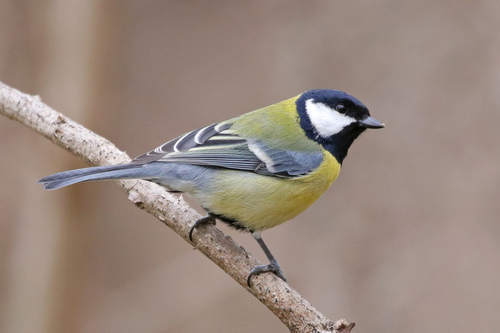
Great Tit
The Great Tit (*Parus major*) is a widespread and easily recognizable passerine bird found throughout Europe and Asia. Known for its striking black and white head, bright yellow underparts, and olive-green back, it's a common sight in gardens, woodlands, and parks. This adaptable bird plays a significant role in controlling insect populations, particularly caterpillars, making it beneficial to both natural ecosystems and human agriculture. Culturally, the Great Tit is often associated with cheerfulness and resilience due to its lively nature and ability to thrive in diverse environments, including urban settings.
12.5-14 cm
Length
22.5-25.5 cm
Wingspan
Least Concern
Conservation Status
Distribution
The Great Tit has an extensive range, covering most of Europe, the Middle East, Central Asia, and parts of North Africa. It extends eastward across Siberia to the Russian Far East and south into parts of Southeast Asia. It is largely resident, but northern populations may migrate south in winter.
Lifespan
The average lifespan in the wild is around 3 years, but some individuals have been recorded living up to 15 years.
Great Tit's Habitat
Habitat Types
Deciduous woodlands, Mixed forests, Parks, Gardens, Hedgerows, Orchards
Climate Zones
Temperate, Boreal, Mediterranean
Adaptations
Great Tits are highly adaptable to various habitats. Their strong beaks allow them to exploit a wide range of food sources, and their agility helps them navigate complex tree canopies and access food in tight spaces. They readily utilize human-provided resources like bird feeders and nest boxes.
Variations
Numerous subspecies of Great Tit exist, differing subtly in plumage coloration and size. For instance, *Parus major major* is the nominate subspecies found across much of Europe, while *Parus major minor* is found in East Asia and tends to be smaller with slightly different markings.
Appearance
Breeding Plumage
Plumage is generally consistent year-round, though it may appear brighter during the breeding season due to fresher feathers.
Seasonal Feather Changes
Minimal seasonal variation; colors may be slightly duller after molting.
Sex Based Plumage Differences
Males typically have a broader black band running down their breast and belly, while females have a narrower and sometimes broken band. The male's black cap is also often glossier.
Notable Features
Black cap and throat, White cheeks, Yellow underparts with a central black stripe, Olive-green back
Diet and Feeding
Primary Foods
Insects, Caterpillars, Spiders, Seeds, Nuts, Berries
Foraging Behavior
Great Tits are active foragers, searching for food on branches, leaves, and the ground. They often hang upside down to reach insects on the undersides of leaves. They are also frequent visitors to bird feeders, where they readily consume seeds and suet.
Specializations
Their strong beaks allow them to crack open seeds and nuts. They also have good spatial memory, remembering locations where they have cached food.
Seasonal Diet Variations
During the breeding season, their diet consists mainly of insects, especially caterpillars, which are crucial for feeding their young. In winter, they rely more on seeds, nuts, and berries.
Behavior
Social Structure
Great Tits are generally territorial during the breeding season, defending their nesting area. Outside of the breeding season, they may form small flocks, sometimes joining mixed-species foraging groups.
Communication
Wide range of vocalizations, including songs and calls., Songs are used for territory defense and mate attraction., Calls are used for communication within flocks and alarm signals.
Migration
Most populations are resident, meaning they stay in the same area year-round. However, some northern populations may undertake short-distance migrations in response to harsh winter conditions.
Territorial or Group Behaviors
During breeding, they are strongly territorial, aggressively defending their nest site from other Great Tits and potential predators. In winter, they can be more social, forming flocks to forage.
Conservation
Threats
Habitat loss and degradation, Pesticide use (reducing insect prey), Competition with invasive species, Climate change (affecting breeding timing and food availability)
Protection Programs
Habitat restoration and protection initiatives, Promotion of sustainable gardening practices, Provision of nest boxes
Local National Laws
Protected under various national and international wildlife protection laws, such as the EU Birds Directive.
Population Trend
Stable
Population Estimates
The global population is estimated to be in the hundreds of millions, making it one of the most numerous bird species.
Interesting Facts
Great Tits have a remarkably diverse repertoire of songs.
Different populations have distinct 'dialects,' and individual males can have dozens of different song variations.
They are known for their intelligence and problem-solving abilities.
Studies have shown they can learn to solve puzzles to access food and can adapt quickly to new feeding opportunities.
Great Tits are important predators of caterpillars.
A single pair of Great Tits can consume thousands of caterpillars while raising their young, helping to control pest populations.
Great Tits sometimes utilize tools.
Captive birds have demonstrated the ability to use small sticks to extract food that is out of reach.
Faqs about Great Tit
What do Great Tits eat?
Great Tits have a varied diet. They mainly eat insects and spiders in the summer. In the winter, they will eat seeds, nuts and berries.
Where do Great Tits nest?
Great Tits nest in cavities, such as tree holes or nest boxes. They build a cup-shaped nest using moss, grass, feathers, and animal hair.
Are Great Tits migratory?
Most Great Tits are resident, but some northern populations may migrate short distances in winter.
How can I attract Great Tits to my garden?
Provide food sources like bird feeders with seeds, nuts, and suet. Install nest boxes to offer nesting sites. Planting native trees and shrubs also provides natural food and shelter.
How long do great tits live?
The average lifespan is around three years. But the record is 15 years.
Copyright @ Nature Style Limited. All Rights Reserved.
 English
English